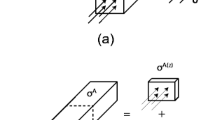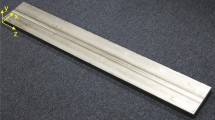Abstract
This paper further explores the primary slice removal technique for planar mapping of multiple components of residual stress and describes application to specimens with a range of alloys, geometries, and stress distributions. Primary slice release (PSR) mapping is a combination of contour and slitting measurements that relies on decomposing the stress in a specimen into the stress remaining in a thin slice and the stress released when the slice is removed from a larger body. An initial contour method measurement determines a map of the out-of-plane stress on a plane of interest. Subsequently, removal of thin slices and a series of slitting measurements determines a map of one or both in-plane stress components. Four PSR biaxial mapping measurements were performed using an aluminum T-section, a stainless steel plate with a dissimilar metal slot-filled weld, a titanium plate with an electron beam slot-filled weld, and a nickel disk forging. Each PSR mapping measurement described herein has one (or more) complementary validation measurement to confirm the technique. Uncertainty estimates are included for both the PSR mapping measurements and the validation measurements. Agreement was found between the PSR mapping measurements and validation measurements showing that PSR mapping is a viable technique for measuring residual stress fields.





















Similar content being viewed by others
References
Prime MB, Steinzig ML (2014) Beyond the streetlight effect: a united future for relaxation and diffraction methods for residual stress measurement. Adv Mater Res 996:234–242
Prime MB (2001) Cross-sectional mapping of residual stresses by measuring the surface contour after a cut. J Eng Mater Technol 123(2):162–168
Pagliaro P et al (2011) Measuring inaccessible residual stresses using multiple methods and superposition. Exp Mech 51(7):1123–1134
Hosseinzadeh F, Bouchard PJ (2013) Mapping multiple components of the residual stress tensor in a large P91 steel pipe girth weld using a single contour cut. Exp Mech 53(2):171–181
Pagliaro P, Prime MB, Swenson H, Zuccarello B (2010) Measuring multiple residual stress components using the contour method and multiple cuts. Exp Mech 50(2):187–294
Pagliaro P et al (2008) Mapping multiple residual stress components using the contour method and superposition. In: ICRS-8-international conference on residual stresses, vol 52. pp 1–8
Pagliaro P, Prime MB, Clausen B, Lovato ML, Zuccarello B (2009) Known residual stress specimens using opposed indentation. J Eng Mater Technol 131(3):031002
Pagliaro P, Prime MB, Zuccarello B, Clausen B, Watkins TR (2007) Validation specimen for contour method extension to multiple residual stress components. Experimental analysis of Nano and Engineering Materials and Structures 635–636. https://doi.org/10.1007/978-1-4020-6239-1_315
Olson MD, Hill MR (2015) A new mechanical method for biaxial residual stress mapping. Exp Mech 55(6):1139–1150
Prime MB, Hill MR (Apr. 2006) Uncertainty, model error, and order selection for series-expanded, residual-stress inverse solutions. J Eng Mater Technol 128(2):175–185
Lee MJ, Hill MR (2007) Intralaboratory repeatability of residual stress determined by the slitting method. Exp Mech 47(6):745–752
Kotobi M, Honarpisheh M (2016) Uncertainty analysis of residual stresses measured by slitting method in equal-channel angular rolled Al-1060 strips. J Strain Anal Eng Des 52(2):83–92. https://doi.org/10.1177/0309324716682124
Olson MD, Hill MR, Patel VI, Muránsky O, Sisneros T (2015) Measured biaxial residual stress maps in a stainless steel weld. J Nuc Eng Rad Sci 1(4):1–11
Hill MR, Olson MD, DeWald AT (2016) Biaxial residual stress mapping for a dissimilar metal welded nozzle. J Press Vessel Technol 138(1):011404
Olson MD, Robinson JS, Wimpory RC, Hill MR (2016) Characterisation of residual stresses in heat treated, high strength aluminium alloy extrusions. Mater Sci Technol 32(14):1427–1438
Hill MR, Olson MD, DeWald AT (2014) Biaxial residual stress mapping for a dissimilar metal welded nozzle. In: ASME 2014 pressure vessels & piping division conference
Prime MB, DeWald AT (2013) The contour method. In: Schajer GS (ed) Practical residual stress measurement methods, Ch 5. Wiley, West Sussex, pp 109–138
Schajer GS, Prime MB (2006) Use of inverse solutions for residual stress measurements. J Eng Mater Technol 128:375
Hill MR (2013) The slitting method. In: Schajer GS (ed) Practical residual stress measurement methods. Wiley, West Sussex, pp 89–108
Olson MD, DeWald AT, Hill MR, Prime MB (2014) Estimation of uncertainty for contour method residual stress measurements. Exp Mech 55(3):577–585
Olson MD, DeWald AT, Hill MR (2018) Validation of a contour method single-measurement uncertainty estimator. Exp Mech 58:767–781. https://doi.org/10.1007/s11340-018-0385-4
SAE Aerospace (2006) Aerospace material specification 4342: aluminum alloy extrusions: solution heat treated, stress relieved, straightened, and overaged. 400 Commonwealth Drive, Warrendale, PA 15096, USA: SAE Aerospace; 2006. Report No.: 4342
Wong W, Hill MR (2013) Superposition and destructive residual stress measurements. Exp Mech 53(3):339–344
ISO (2005) Non-destructive testing - standard test method for determining residual stresses by neutron diffraction. International organization for standardization, ISO/TS 21432
Coleman HW, Steele WG (2009) In Experimentation, Validation, and Uncertainty Analysis for Engineers, 3rd edn. Wiley, Hoboken
Prime MB, Gnäupel-Herold T, Baumann JA, Lederich RJ, Bowden DM, Sebring RJ (2006) Residual stress measurements in a thick, dissimilar aluminum alloy friction stir weld. Acta Mater 54(15):4013–4021
Rangaswamy P et al (2005) Residual stresses in LENS® components using neutron diffraction and contour method. Mater Sci Eng A 399(1–2):72–83
Hosseinzadeh F, Toparli MB, Bouchard PJ (2012) Slitting and contour method residual stress measurements in an edge welded beam. J Press Vessel Technol 134(1):011402
Chantzis D, Van-der-Veen S, Zettler J, Sim WM (2013) An industrial workflow to minimise part distortion for machining of large monolithic components in aerospace industry. Procedia CIRP 8:281–286
Sim WM (2011) Residual stress engineering in manufacture of aerospace structural parts. Proceedings of 3rd international conference on distortion engineering. Bremen, Germany, pp 187–194
Li J-G, Wang S-Q (2017) Distortion caused by residual stresses in machining aeronautical aluminum alloy parts: recent advances. Int J Adv Manuf Technol 89:997–1012
Masoudi S, Amini S, Saeidi E, Eslami-Chalander H (2015) Effect of machining-induced residual stress on the distortion of thin-walled parts. Int J Adv Manuf Technol 76(1):597–608
Wang Z-J, Chen W-Y, Zhang Y-D, Chen Z-T, Liu Q (2005) Study on the machining distortion of thin-walled part caused by redistribution of residual stress. Chin J Aeronaut 18(2):175–179
Garcia DR, Hill MR, Aurich JC, Linke BS (2017) Characterization of machining distortion due to residual stresses in quenched aluminum. In: Proceedings of the ASME 2017 12th international manufacturing science and engineering conference, Los Angeles, CA, USA
Acknowledgements
The authors acknowledge, with gratitude, the U.S. Air Force for providing financial support for this work (contract FA8650-14-C-5026). We would also like to acknowledge Steve McCracken from the Electric Power Research Institute for suppling and fabricating the stainless steel plate with a dissimilar metal slot-filled weld, Brian Streich from Honeywell for providing the nickel forgings, and Andrew Mugnaini from Sciaky for fabricating the titanium samples. Special acknowledgement to Jeffrey Bunn, Paris Cornwell, and Andrew Payzant from Oak Ridge National Laboratory for their help with the neutron diffraction measurements.
A portion of this research was performed at ORNL’s High Flux Isotope Reactor and was sponsored by the Scientific User Facilities Division, Office of Basic Energy Sciences, US Department of Energy (proposal IPTS 14081.1).
Author information
Authors and Affiliations
Corresponding author
Rights and permissions
About this article
Cite this article
Olson, M.D., DeWald, A.T. & Hill, M.R. Assessment of Primary Slice Release Residual Stress Mapping in a Range of Specimen Types. Exp Mech 58, 1371–1388 (2018). https://doi.org/10.1007/s11340-018-0420-5
Received:
Accepted:
Published:
Issue Date:
DOI: https://doi.org/10.1007/s11340-018-0420-5




